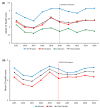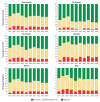Temporal Trends in Cardiovascular Health Metrics in Italy, 2015-2024: A Ten-Year Report from the Longevity Check-Up (Lookup) 8+ Study
- PMID: 41283252
- PMCID: PMC12641886
- DOI: 10.3390/medsci13040251
Temporal Trends in Cardiovascular Health Metrics in Italy, 2015-2024: A Ten-Year Report from the Longevity Check-Up (Lookup) 8+ Study
Abstract
Background/objectives: The objective of this ten-year report is to describe temporal trends in the cardiovascular health (CVH) score and its individual components across ages and sexes. We also examined the impact of the post-COVID-19 period on ideal CVH and identified demographic predictors of favorable cardiovascular risk profiles.
Methods: Data for this cross-sectional study were collected between 2015 and 2024 as part of the Lookup 8+ project, an ongoing initiative integrating field-based CVH assessments across Italy. CVH was operationalized using a modified CVH score (0-7 points) inspired by Life's Simple 7, combining behavioral and clinical metrics. Trends over time and across demographic groups were examined using descriptive statistics and multivariable models adjusted for age, sex, and year of assessment.
Results: The study included 18,491 participants (mean age 56.1 ± 14.8 years; 55.2% women). After an initial decline in CVH score between 2015 and 2017 (mean score from 4.39 to 3.95), a gradual improvement followed, reaching 4.41 in 2024. Younger adults (18-39 years; 71.9% in 2024) and women (56.8%) consistently showed the highest prevalence of ideal CVH (score ≥ 5). The post-COVID-19 period was independently associated with higher odds of ideal CVH (OR 1.32; 95% CI 1.24-1.40). While blood pressure and cholesterol metrics improved, dietary quality and glycemic control worsened over time.
Conclusions: From 2015 to 2024, overall CVH improved among Lookup participants, particularly among younger individuals after the COVID-19 pandemic. However, substantial age- and sex-related gaps remain, requiring targeted and equity-oriented prevention efforts.
Keywords: COVID-19 pandemic; Life’s Simple 7; cardiovascular health; health behavior; health surveys; primary prevention; public health surveillance; risk factors.
Conflict of interest statement
The authors declare no conflicts of interest.
Figures




References
-
- Roth G.A., Mensah G.A., Johnson C.O., Addolorato G., Ammirati E., Baddour L.M., Barengo N.C., Beaton A.Z., Benjamin E.J., Benziger C.P., et al. Global Burden of Cardiovascular Diseases and Risk Factors, 1990-2019: Update From the GBD 2019 Study. J. Am. Coll. Cardiol. 2020;76:2982–3021. doi: 10.1016/j.jacc.2020.11.010. - DOI - PMC - PubMed
-
- Global Cardiovascular Risk C., Magnussen C., Ojeda F.M., Leong D.P., Alegre-Diaz J., Amouyel P., Aviles-Santa L., De Bacquer D., Ballantyne C.M., Bernabe-Ortiz A., et al. Global Effect of Modifiable Risk Factors on Cardiovascular Disease and Mortality. N. Engl. J. Med. 2023;389:1273–1285. doi: 10.1056/NEJMoa2206916. - DOI - PMC - PubMed
-
- Lloyd-Jones D.M., Hong Y., Labarthe D., Mozaffarian D., Appel L.J., Van Horn L., Greenlund K., Daniels S., Nichol G., Tomaselli G.F., et al. Defining and setting national goals for cardiovascular health promotion and disease reduction: The American Heart Association’s strategic Impact Goal through 2020 and beyond. Circulation. 2010;121:586–613. doi: 10.1161/CIRCULATIONAHA.109.192703. - DOI - PubMed
-
- Lloyd-Jones D.M., Allen N.B., Anderson C.A.M., Black T., Brewer L.C., Foraker R.E., Grandner M.A., Lavretsky H., Perak A.M., Sharma G., et al. Life’s Essential 8: Updating and Enhancing the American Heart Association’s Construct of Cardiovascular Health: A Presidential Advisory From the American Heart Association. Circulation. 2022;146:e18–e43. doi: 10.1161/CIR.0000000000001078. - DOI - PMC - PubMed
-
- Aguayo L., Cotoc C., Guo J.W., Labarthe D.R., Allen N.B., Marino B.S., Davis M.M., Uttal S., Lloyd-Jones D.M., Perak A.M. Cardiovascular Health, 2010 to 2020: A Systematic Review of a Decade of Research on Life’s Simple 7. J. Am. Heart Assoc. 2025;14:e038566. doi: 10.1161/JAHA.124.038566. - DOI - PMC - PubMed
MeSH terms
LinkOut - more resources
Full Text Sources
Medical

